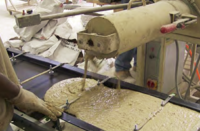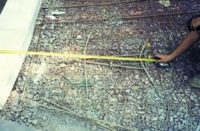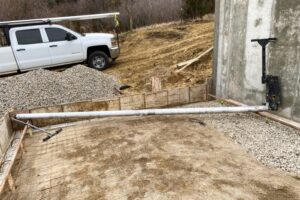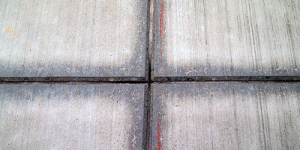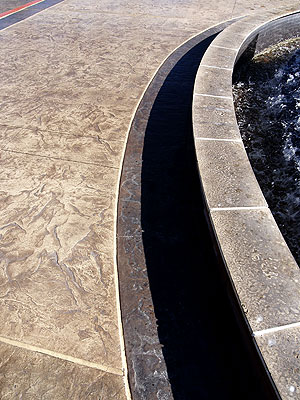 Most professionals agree that nearly all concrete slabs will, over the course of time, crack. The reasons are widely known.
Most professionals agree that nearly all concrete slabs will, over the course of time, crack. The reasons are widely known.
Concrete contracts as it cures. It shrinks and expands with changes in ambient temperatures. Unfortunately, due to friction and other forces, concrete slabs rarely shrink and expand as solid monolithic units. Barring extraordinary efforts such as post-tensioning, cracks usually appear. Although they generally do not affect the integrity of the slab, irregular concrete cracks are unsightly, difficult to maintain, and often pose aesthetic problems for those in the decorative concrete business.
Disheartening as the concept of inevitable cracking may seem to home or business owners, decorative concrete professionals have a few tricks up their collective sleeves to make cracks seem all but invisible.
“If you can’t beat them, join them,” could be the motto of seasoned concrete professionals. Rather than stressing out over stress cracks, industry professionals have long relied on contraction joints (see sidebar, “The Rules of Contraction”) to control cracking. Placed on the surface of concrete slabs and created by forming, tooling or sawing, these joints weaken the slab to provide attractive avenues in which cracks form. Cracks formed inside these joints are relatively easy to disguise.
Placing contraction joints in concrete is not exactly rocket science. While care must be taken in the joints’ design and creation, three fundamentals come into play. First, maximum joint spacing should be 24 to 36 times the thickness of the slab, with a maximum spacing of 15 feet. Second, the minimum depth of a joint should be a fourth of the thickness of the concrete. Third, all panels created by contraction joints should be as square as possible.
Harder than rocket science
Those involved in decorative concrete may find themselves at odds with square or rectangular contraction joints. They may be working with circular slabs and not wish to break up the flow of the surface with straight angles. Radial shapes such as those found around fountains or graceful flowing lines around swimming pools seem to invite curved contraction joints.
Installing shallow, decorative joints may be as simple as grinding the surface with a router. But placement and installation of curved contraction joints isn’t easy.
“You’re usually going to see curved joints in a radius or another layout that the architect establishes to go along with whatever type of theme or architecture they’re employing,” says Mike Riggs, president of Phoenix-based Progressive Concrete Works Inc. “We use curved contraction joints when we’re trying to tie the design of the building and the hardscape. The curving lines become part of the overall architecture of the building.”
It’s not always easy to control cracks in curved or radial joints, Riggs says.
“Concrete typically likes to crack in a square. A good rule of thumb when you’re dealing with square or rectangular shapes is if you’ve got a 10-foot-by-10-foot slab, you’re okay. If it’s a 10-foot-by-20-foot, it’s going to want to crack right down the middle of the rectangle.”
Transferring that rule of thumb to curved shapes, it’s easy to imagine the type of areas that would host runaway cracks. “What’s tough is where you get into areas with where you start to get sharper points, for lack of a better description,” Riggs says.
By way of example, imagine a pie-shaped section of concrete. The narrow area will have a tendency to crack off, as though someone has taken a bite of it.
Crack control
Hand-tooling curves at Progressive Concrete is often done freehand with the same joiner one might use for linear control joints, according to Riggs. Progressive Concrete professionals typically mark a few points to use as guideposts.
But saw-cut joints, defined by the American Concrete Institute as those cut at less than full depth with special equipment in hardened concrete, are generally approached differently on curves than on straight lines. With the minimum recommended depth of one fourth of the thickness of the concrete, getting the saw to turn can be very tough.
“You really can’t cut a tight radius control joint, because the saw blade will bind up,” Riggs says. “You can do it, but only on a real wide-sweeping turn. Anything tighter, and you need a dry-cut saw and the joint will be more for aesthetic reasons than crack control.”
Allen Roeber, president of Best Stamped Concrete Inc., based in Huntsville, Ala., combines saw cuts with hand-tooled contraction joints whenever he can.
“We like to go back the next day and saw-cut them to make sure the concrete cracks on that joint,” Roeber says. “On 4-inch concrete, 80 percent of the time a 1-inch control joint is going to do the job, but for extra insurance why not saw cut it 2 inches deep? You’re pretty much guaranteed it will crack in the joint.”
Rather than working freehand, Roeber’s Best Stamped Concrete crews work with guides, using a 2-by-4 as a guide for a straight joint, PVC pipe for a curved joint.
Especially when following tight curves such as those found near the center of radial patterns, decorative concrete specialists are more likely to work with shallower joints.
The very best joints will not only blend in, but help bring together design elements of the hardscape and nearby structures. “The trick is to make your eyes follow elements such as shapes and colors within the architectural joints and not focus in on the structural control joints,” says Riggs. “But this type of finesse doesn’t always show up on blueprints. That’s something you need to point out to the architects, because if they don’t know what you’re going to do, they might think you’re going to destroy their design.”
Special Note
The Rules of Contraction
According to the American Concrete Institute’s online Cement and Concrete Terminology guide, contraction joints (also called control joints, among other names) exist to “create a weakened plane to regulate the location of cracking resulting from the dimensional change of different parts of the structure.”
Contraction joints are broadly categorized by ACI according to their function.
Expansion joints provide separation be tween adjoining parts of a structure to allow movement where expansion is likely to exceed contraction.
Isolation joints provide a separation between adjoining concrete structure compo nents to allow movement.
Construction joints exist between two successive placements of concrete — for instance, where work has stopped one day and continued the next.
An electronic search performed by ACI staff of the most current Manual of Concrete Practice and other publications turned up no reference to curved contraction joints.
